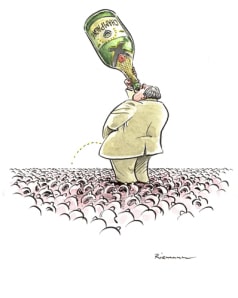In economics, the trickle down effect suggests that low-income groups benefit indirectly from the accumulation of wealth by those who earn high income – income is said to trickle down from the rich to the poor.
There’s an enticing analogy to scientific knowledge here – the accumulation of knowledge by the scientists and researchers might, one day, trickle down to those who have less knowledge. In the case of pain science, the hope, perhaps, is that the knowledge will trickle down to those who need it the most – people experiencing chronic pain.
But the trickle down effect has been criticised for an excuse to keep the infamous “1%”, in, the top 1%. If a picture tells a thousand words, then this one sums up that criticism….

Reading an article in Scientific American recently had me thinking about the trickle down effect. Back in August, Scientific American suggested:
5 Ways to Treat Chronic Pain
More than 1.5 billion people around the world suffer from chronic aches and pains. Often these discomforts are felt daily, and their effects can be debilitating…
Fortunately several approaches to chronic pain management may bring some relief.
1. Yoga
2. Cognitive Behavioural Therapy
3. Antidepressants
4. Deep-Brain Stimulation
5. Sympathectomy
Each point was accompanied by “The Evidence” which usually consisted of the results of one (did someone say cherry picked?) study or, in the case of Sympathectomy, this explanation which seemed to make a lie of the label on the tin:
“The Evidence: Scientists agree that malfunctioning sympathetic nerves contribute to chronic pain but sympathectomy remains controversial. Few scientifically strong studies of the procedure exist and it can have serious complications. Nevertheless, some researchers believe in the intervention’s potential. In one of the stronger studies to date, published in 2008, anesthesiologist Prashanth Manjunath, now at Bingham Memorial Hospital in Idaho and his colleagues found that those who received a sympathectomy by either injecting an anesthetic into the nerve area or heating tissue with radio waves had a 50 to 75 percent reduction in pain that lasted more than four months.”
The list left me feeling a bit disheartened – what will trickle down from this? Popular media with a larger readership might pick this up and, simplifying even further, drop the “evidence” sections and lead with a snappy headline like “5 guaranteed remedies for chronic pain.” I can even see “5 secret cures for chronic pain that your doctor does’t want you to know about” – anyone who has spent time on the internet recently will be familiar with this approach to gaining ‘clicks’. What eventual “knowledge” will the people who need it the most, receive?
If we aspire to the goal of Pain Education for All, then this needs to be achieved actively – even vigorously. Of course, there will be resistance – some will accuse those trying to take a pain science message to people in pain as evangelising, being biased, setting themselves up as gurus, being naysayers, throwing out the ‘bio’ to focus only on the ‘psychosocial’ or trying to destroy various therapeutic professions. But, I think this is just one of many examples of why we can’t rely on any trickle down effect for pain knowledge. Modern therapists treating people experiencing pain will need to consider and develop a curriculum for the individual patients they see- purposefully planning what to teach, how to teach it and what resources and evidenced based multimedia approaches they will use. All this needs to be backed up with a deep knowledge of what is to be taught. It is a lot to ask, but its necessary to begin to dig ourselves out of the iatrogenic hole that we find ourselves in.
Tim Cocks
Four great minds in neurobiology, bioplasticity, education and psychology come together over 3 big days to deliver the most up to date and comprehensive Explain Pain package yet. #2015ep3 – its happening!

I have just started incorporating this pain science education into practice and with great results. I wish I would have done it sooner because it would have helped me a lot as a young therapist. But hindsight is 20/20 right. I’m still working on my own curriculum within myself… It’s a growing, ever changing struggle to know what analogies to use, what stories to tell, what research to present in a patient friendly yet accurate way but at the end of the day, I am encouraged by the results I have had so far
Thanks – that word “curriculum” is so important – we often don’t consider it in health. I like that you are considering your “own curriculum”.
“Curriculum” bring up things like what do I teach, how do I deliver, how to I manage outliers, how do I measure?
David
Yes, yes and yes……..each patient is an unique individual and as such needs an unique and ever accomadating curriculum ……..
DB London
On location😎☀️🎄🎅🍗